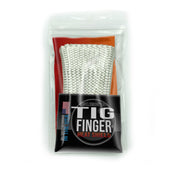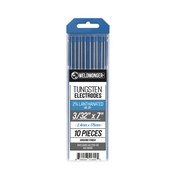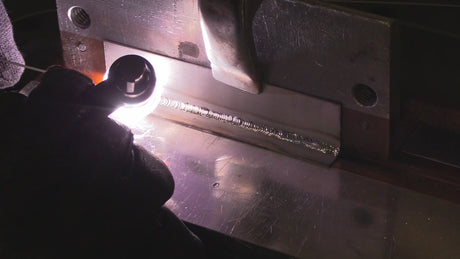TIG Welding Titanium is not all that difficult to weld.
Unless you make one of these 3 big mistakes.
So what are the 3 biggest mistakes when TIG welding Titanium?
How to Avoid the 3 Biggest Mistakes for tig welding titanium
1. Not recognizing or knowing that you are dealing with Titanium
This usually happens in a repair situation.
someone brings you an exhaust part, a foot peg from a motorcycle, and you don't immediately recognize that it is made out of titanium.
After years of experience, you get pretty good at recognizing titanium when you see it but an inexperienced welder might not immediately notice a titanium part.
This becomes a big problem if stainless filler metal is used to make a repair weld.
Now all of a sudden, a 30 minute job turns into a 3 hour rescue mission.
All of the stainless material needs to be removed...all of it.
This can all be avoided by using a simple spark test before attempting to do any weld repair.
A simple angle grinder with a sanding disc will reveal if a part is titanium.
Sparks from titanium are bright white sparks and shoot farther than stainless.

Another way titanium is sometimes welded with the wrong filler metal is when you leave filler rods laying about on your welding bench.
I've seen this happen a few times where someone didn't bother to clean up leftover filler metal off their bench and just grabbed the wrong filler on a titanium job. They knew the part was titanium but just accidentally grabbed the wrong filler because it was laying there.
A little housekeeping goes a long way. ( I am coaching myself here too)
2, Not shielding the penetration side with Argon shielding gas
Titanium that is welded with full penetration requires argon shielding on the back side or else it will be very brittle and will likely fail in service.
for example, A titanium exhaust pipe that is cracked should be purged with argon before welding.
There are always exceptions to this rule of thumb but by and large, titanium needs to be purged when the back side of the weld gets molten as in a butt weld.
3. Not cleaning enough
I listed this as number 3 because it is actually 3rd in importance compared to 1 and 2.
Yes Titanium needs to be clean before welding but making sure to only use titanium filler metal and argon purging are the most important 2 things when tig welding titanium.
Improper cleaning will usually result in some amount of porosity.
Porosity is not usually a good thing but is far less a problem than a brittle weld.
Often times, a simple wipe down with acetone is enough.
- Sometimes wire wheeling with a fine bristle stainless cup brush will do the trick.
- Abrasives are sometimes needed but should be fine grit.
- Red scotch brite roloc wheels have been known to cause porosity.
Titanium Weld Certification test tips
A test weld for aerospace welding certification is different than a repair.
Tee joints get sliced and diced, acid etched, and inspected for adequate penetration.
Butt welds get X rayed and the main culprit that will fail you on an Aerospace butt weld on titanium is porosity.
here is what I have found works best.
1. wipe with acetone first before doing any sanding or brushing.
2. use a clean new file to smooth the sheared edge that will be welded and when you think you have filed enough...file a bit more until you cant see any evidence of the rough sheared edge.
3. use a new clean fine bristly cup brush with a low rpm grinder to clean the weld area about 1/2" back from edge.
4. wipe fixture down with acetone
5. give the test plates a final wipe down with acetone
6. put test plates in fixture using clean nitrile gloves ( even oil from fingers can cause porosity.)
do NOT use any acetone once plates are in fixture.
7. follow wps for fixture purge gas settings and be careful to not use too much purge gas flow.
8. weld the test.
***I learned the hard way to avoid using the maroon colored scotch brite discs
What is Alpha Case?
Alpha case refers to a brittle and oxygen-rich layer that forms on the surface of titanium when exposed to high temperatures during the welding process.
for a detailed article on tips for preventing alpha case, go here.






3 comments
Jodie
You are by far the best teacher I have ever had. I’ve been watching your videos for 9 years. Thank you so much.
Great videos just reminded me of all the bad habits I have after 45 years of welding
Thanks Jodie best welding instructor on YouTube.